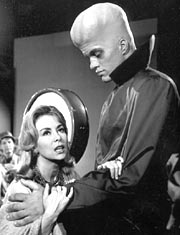
Oldie, but a goodie
The Twilight Zone: To Serve Man
DirecTV Channel #244 Syfy
(12-31-2009) 11:25 - 11:58

Posted on 12/31/2009 9:53:37 AM PST by Fractal Trader
In the autumn of 1913, two farmers were arguing about hominid skull fragments they had uncovered while digging a drainage ditch. The location was Boskop, a small town about 200 miles inland from the east coast of South Africa.
These Afrikaner farmers, to their lasting credit, had the presence of mind to notice that there was something distinctly odd about the bones. They brought the find to Frederick W. Fitz Simons, director of the Port Elizabeth Museum, in a small town at the tip of South Africa. The scientific community of South Africa was small, and before long the skull came to the attention of S. H. Haughton, one of the country’s few formally trained paleontologists. He reported his findings at a 1915 meeting of the Royal Society of South Africa. “The cranial capacity must have been very large,” he said, and “calculation by the method of Broca gives a minimum figure of 1,832 cc [cubic centimeters].” The Boskop skull, it would seem, housed a brain perhaps 25 percent or more larger than our own.
The idea that giant-brained people were not so long ago walking the dusty plains of South Africa was sufficiently shocking to draw in the luminaries back in England. Two of the most prominent anatomists of the day, both experts in the reconstruction of skulls, weighed in with opinions generally supportive of Haughton’s conclusions.
The Scottish scientist Robert Broom reported that “we get for the corrected cranial capacity of the Boskop skull the very remarkable figure of 1,980 cc.” Remarkable indeed: These measures say that the distance from Boskop to humans is greater than the distance between humans and their Homo erectus predecessors.
(Excerpt) Read more at discovermagazine.com ...
If I were an elephant, I would find a way so I didn’t have to do everything with my nose.
But again, we have no record of exactly what those cavities were filled with. They might have been more stupid than Alfred E. Neumann and yet capable of more prestidigitation than a Liberace, and we’d never know it because all we got are bones.
“...The ancient people did not mysteriously disappear: they are still with us! The artistic legacy of the ancient peoples, clearly evidenced in rock art, is impressive but no more so than that of the European Upper Paleolithic or that of indigenous Australians.
And their brains were not all that big....”
http://johnhawks.net/weblog/reviews/brain/paleo/lynch-granger-big-brain-boskops-2008.html
***THEIR MALES ALL MARRIED EACH OTHER ***
and the females all aborted their children so they could live the good life.
They’re dead now....obviously big brains didn’t help em.


What do you mean "Us", Kimosabe?

"They tasted like chicken."
There are plenty of apes smarter than some humans.
With mango sauce?
Isn’t it pretty widely conceded that Neandertals had brains 10-15% larger than modern humans?
Didn’t help them much! It was the “ugly” that killed em off!
The entire show was excellent, covering genetic diseases, how mutation of DNA occurs and how it has affected everything.
Elephant’s brains are not bigger than human brains, surprisingly. And the animal with the biggest brain is the sperm whale!
Pretty much describes these shy, introspective and peace-loving creatures:

This would explain why we can never catch them: they are too smart.
Impossible. It says here they were smart.
Oops, I retract that statement. It seems that comparative to body size, humans have more brains. But elephants’ brains are actually larger.
Dumb and vicious beats smart and gentle every time.
ROFLMAO!
Have you heard the joke involving an elephant’s trunk, a severed appendage to be replaced, and a box of popcorn?
Disclaimer: Opinions posted on Free Republic are those of the individual posters and do not necessarily represent the opinion of Free Republic or its management. All materials posted herein are protected by copyright law and the exemption for fair use of copyrighted works.